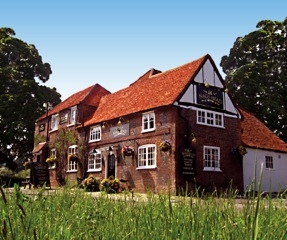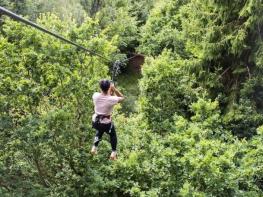Inglenook Cottage is a period property 1/2 mile of the village shop, and restaurants. Consisting…
Up Coombe Hill

4 miles (6.4kms)
About the walk
The old market town of Wendover is a popular and pretty commuter settlement, with a frequent train service to London Marylebone. The regular route to London, some 40 miles (64km) southeast, is nothing new. In the early 1800s a stagecoach ran to Holborn from the Red Lion on the High Street. Long before that the ancient Icknield Way trade route, one of the oldest roads in the country, passed right through the town and brought prosperity. In 1533 Henry VIII’s recorder, John Leland, visited Wendover and recorded, 'A town having two streets, well builded with tymbre'. It remains essentially a two-street town, built around the axis of High Street/Tring Road and Aylesbury Road, and many timber properties remain, albeit remodelled over the centuries. Behind the landmark Clock Tower at the bottom of the High Street flows the chalk stream that gives Wendover its name (it means 'white waters'); a watermill, first recorded in the Domesday Book, last worked in 1923, is also to be found here.
Today, a much noisier route than the old stagecoach threatens to disrupt Wendover’s peace and quiet, if the High Speed 2 (HS2) rail line from London to the Midlands takes its proposed route immediately west of the town, passing through a tunnel and across viaducts uncomfortably close to the town centre.
Coombe Hill
Just a short walk from the centre, Coombe Hill – 106 acres (43ha)of downland – rises 852ft (260m) above sea level and is the highest accessible viewpoint in the Chilterns. The grand 60ft (18.3m) monument atop the hill is a memorial to 148 men of Buckinghamshire who died in South Africa during the Boer War (1899–1902). Erected by public subscription in 1904, it was struck by lightning in 1938 and later rebuilt. In 1972 the bronze tablet attached to the memorial was stolen. A stone one replaces it.
There are magnificent views from here over a sizeable area of the county, particularly the Aylesbury Vale, with Aylesbury some 5 miles (8km) due north. Gliders often swoop silently into view in the skies above. Almost immediately west is Pulpit Hill, home to the remains of an ancient hill-fort. Chequers, the country home of the Prime Minister, lies 0.75 miles (1.2km) in this direction. From the Coombe Hill Memorial it is hidden by trees, but if you walk approximately 100yds (90m) left of the monument, along the Ridgeway trail, and look down to the left, you can see the house.
Walk directions
Turn right out of the High Street car park to visit the tourist office, housed in the distinctive Clock Tower, which was built as a small market hall in 1842. Pick up a town trail map here. Cross (with care) the Aylesbury Road diagonally to walk up Back Street, parallel to the High Street. Once part of the ancient Icknield Way, Back Street is still lined with old traders' cottages dating from the 16th, 17th and 18th centuries. At Dobbins Lane turn left, then right back onto the High Street, and pass the railway station. Cross the road, and once you are over the bridge, look for a waymarked footpath left.
Go over two stiles, towards pylons. Head diagonally right across the field to go over another stile. Turn right uphill along the lane. After about 90yds (82m) turn left, following the bridleway beside a modern house, and go along the track as it swings round to the right, passing a stile (marked private). Go to the end of the field and turn right through a metal gate.
Follow the path between wire fences as it first dips then sweeps uphill, for around 0.75 miles (1.2km). As the track flattens out, turn right onto a bridleway. After about 160yds (146m) cross a private drive. The path ahead splits – take the right-hand footpath with the fence to your right. After around 200yds (183m) turn sharp left at a waymarker post along a muddy footpath, following the yellow arrows painted on the trees through the wood. In late spring there is a spectacular carpet of bluebells here.
Follow this path until the next waymarker at a T-junction. Turn right and continue ahead for around 275yds (251m), then turn left at the next waymarker and follow the path through a short, dark, wooded area to Coombe Hill and a National Trust car park. Go through the gate, pass a picnic area (right), and take the footpath which veers to the left and goes across the plateau to reach the monument.
After enjoying the spectacular views across the Vale of Aylesbury, continue right, following the black Ridgeway waymarker post (just below you). The route now descends slowly via a series of gates and, close to the road, a flight of steps, all the way back down to the road. At the road, turn right and continue past the railway station to the High Street. Note the lovely old Tudor houses on the right, once the old post office, now housing antiques dealers, and further along, on the left, Rumsey’s Chocolaterie, set in an old bank. Return to the car park.
Additional information
Wendover town centre, field and woodland paths and tracks; 3 stiles
Chiltern country, a mixture of rolling hills and woodland
Lead required in town
AA Walker's Map 24 The Chilterns
High Street car park
High Street car park
WALKING IN SAFETY
Read our tips to look after yourself and the environment when following this walk.
Find out more
Also in the area
About the area
Discover Buckinghamshire
Buckinghamshire is a land of glorious beech trees, wide views and imposing country houses. Victorian Prime Minister Benjamin Disraeli savoured the peace and tranquillity of Hughenden Manor, while generations of statesmen have entertained world leaders at Chequers, the Prime Minister’s rural retreat. Stowe and Waddesdon Manor are fine examples of even grander houses, set amid sumptuous gardens and dignified parkland.
The Vale of Aylesbury is a vast playground for leisure seekers with around 1,000 miles (1,609km) of paths and tracks to explore. Rising above it are the Chiltern Hills, a designated Area of Outstanding Natural Beauty covering 308sq miles (798sq km). They are best appreciated in autumn, when the leaves turn from dark green to deep brown. In the southeast corner of the Chilterns lie the woodland rides of Burnham Beeches, another haven for ramblers and wildlife lovers. Although the county’s history is long and eventful, it’s also associated with events within living memory. At Bletchley Park, more than 10,000 people worked in complete secrecy to try and bring a swift conclusion to World War II. Further south, an otherwise unremarkable stretch of railway line was made infamous by the Great Train Robbery in the summer of 1963.
Nearby stays
Restaurants and Pubs
Nearby experiences
Recommended things to do
Why choose Rated Trips?
Your trusted guide to rated places across the UK
The best coverage
Discover more than 15,000 professionally rated places to stay, eat and visit from across the UK and Ireland.
Quality assured
Choose a place to stay safe in the knowledge that it has been expertly assessed by trained assessors.
Plan your next trip
Search by location or the type of place you're visiting to find your next ideal holiday experience.
Travel inspiration
Read our articles, city guides and recommended things to do for inspiration. We're here to help you explore the UK.

















